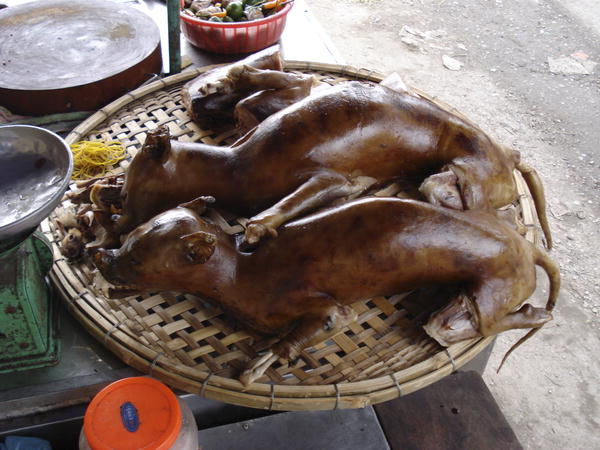The first patient was a 48-year-old male construction worker, with no preceding medical illnesses who was, among other symptoms, unable to swallow due to involuntary inspiratory muscle spasms. The second patient was a 37-year-old male farmer, without any prior medical history and similar symptoms.
The muscle spasms in the presence of water, hydrophobia, was the crucial information piece they used in diagnosing furious rabies. They deduced the rabies resulted from consuming small domestic animals because the first patient had butchered and consumed a dog he found on the road. The second patient killed and ate a sick cat. In both cases they also ate the brains.
Both patients died a short while after being admitted to the hospital.

Mmmm, dog meat at a Market in Hanoi. From: Furious Rabies after an Atypical Exposure Wertheim HFL, Nguyen TQ, Nguyen KAT, de Jong MD, Taylor WRJ, et al. PLoS Medicine Vol. 6, No. 3, e44 doi:10.1371/journal.pmed.1000044
Though their symptoms developed after butchering, preparing, and consuming a dog or a cat, the researchers were unable to test the butchered animals for rabies so they cannot be entirely certain that these animals were the source of the rabies. Nevertheless, they caution that butchering of unvaccinated dogs and cats in rabies-endemic countries should be considered a risk factor for rabies transmission.
The researchers also say that while the brains may have generated more of the rabies virus during preparation, that was not likely the way rabies was contracted because the dishes were cooked and other people ate them without getting symptoms. It is more likely the virus occurred due to contamination of unrecognized cuts on their hands or arms.
Citation: Wertheim HFL, Nguyen TQ, Nguyen KAT, de Jong MD, Taylor WRJ, et al. (2009) Furious Rabies after an Atypical Exposure. PLoS Med 6(3): e1000044 doi:10.1371/journal.pmed.1000044






Comments